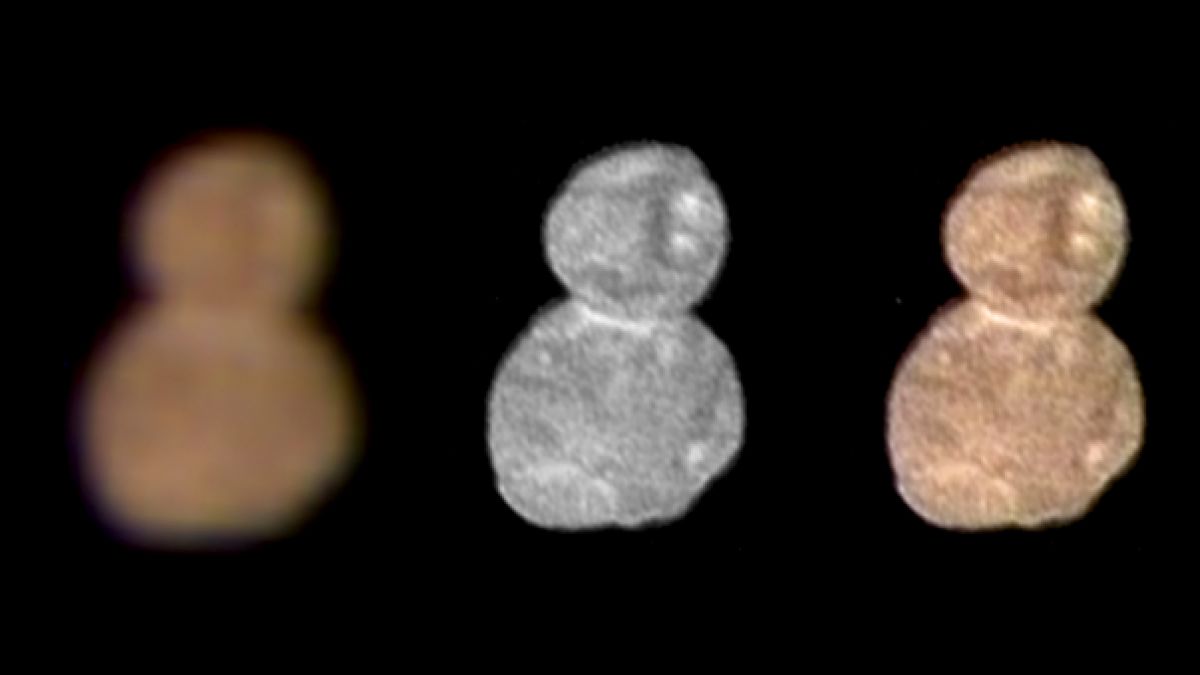Deep in the fringes of our solar system, a curious object nicknamed the “space”snowman”—officially known as Kuiper Belt Object 486958 Arrokoth – has been baffling scientists. A new study is shaking the foundations of our understanding of these distant, icy inhabitants of the Kuiper Belt, a vast region beyond Neptune littered with leftover debris from the solar system’s formation.
A Peek Through Time: A Frozen Treasure Trove Lies Within Arrokoth
Researchers from Brown University and the SETI Institute have discovered that Arrokoth may harbor a secret trove – ancient ices locked away within its core since the object’s birth billions of years ago. This revelation challenges existing assumptions about the fate of ices on these distant objects. Previously, scientists believed that such volatile materials, like carbon monoxide, would have been long lost due to the harsh conditions of deep space, bombarded by cosmic radiation and frigid temperatures.
The new study, published in the journal Icarus, upends these assumptions. Using a novel computer model designed to simulate the evolution of comets, the researchers propose that many Kuiper Belt objects, not just Arrokoth, could be harboring similar time capsules. These primordial ices offer invaluable clues about the composition of the early solar system and the conditions that existed during its birth, potentially helping us understand the very building blocks that formed our cosmic neighborhood. Imagine a pristine record, untouched for eons, waiting to be deciphered.
The Mystery of Disappearing Ices: A Self-Preservation Mechanism in the Frigid Depths
Prior models struggled to explain how temperature-sensitive ices, like carbon monoxide, could persist for such vast stretches of time in the unforgiving environment of the Kuiper Belt. The new model sheds light on this conundrum. It proposes a fascinating self-preservation mechanism that takes advantage of Arrokoth’s extreme coldness.

As ice within Arrokoth sublimates (transforms directly from solid to gas), it creates a barrier for further sublimation. Imagine a domino effect playing out in slow motion within the object’s interior. The act of sublimation itself requires heat, and as the newly formed gas attempts to migrate outwards through Arrokoth’s porous, comet-like core, it inadvertently steals heat from the remaining ice, hindering further sublimation. This chain reaction effectively slows down the entire process, essentially putting the ices in a deep freeze. The frigid temperatures become an ally, creating a natural refrigerator that safeguards these ancient materials.
From Dormant Time Capsules to Volatile Comets: A Trigger for Icy Eruptions
The research suggests a fascinating role for these Kuiper Belt objects – that of celestial “ice bombs” patiently waiting for their moment to erupt. For billions of years, these objects can preserve their volatile treasures in a frozen state. However, when their orbits shift, bringing them closer to the sun’s warmth, the icy equilibrium is disrupted. The heat triggers a surge in sublimation, rapidly pressurizing the built-up gases. This sudden shift transforms the once-dormant object into a vigorously active comet, spewing gas and dust into the cosmic expanse. A celestial metamorphosis unfolds, as the icy time capsule gives way to a dazzling display of cometary activity.
Rethinking Comets and Unveiling the Solar System’s Secrets
The study’s findings have significant implications for our understanding of comet formation and activity. It suggests that these icy outbursts we observe from comets may not be a recent phenomenon, but rather the culmination of a long period of icy buildup and preservation within the frigid depths of the Kuiper Belt. Comets may be far more complex than previously thought, harboring a rich internal history waiting to be unraveled.
The research throws a wrench into existing theories about comet evolution. It compels scientists to re-evaluate the prevailing models and consider the possibility of far more ancient and complex processes at play. The findings could significantly impact future missions like NASA’s Comet Astrobiology Exploration Sample Return (CAESAR) mission, which aims to collect samples from the surface of comet 67P/Churyumov-Gerasimenko. By understanding how these objects preserve their internal materials, scientists can design better strategies for collecting and analyzing these precious samples, potentially unlocking a treasure trove of information about the origins and evolution of our solar system.
The icy revelations from the “space snowman” study paint a picture of a universe brimming with frozen secrets. These ancient time capsules, preserved within countless icy bodies throughout the outer solar system, offer a chance to peer back in time and learn more about the building blocks that formed our cosmic neighborhood. Future exploration efforts may one day allow us to retrieve these frozen messengers and bring them home to Earth, where they can be meticulously studied, revealing the secrets locked away



















